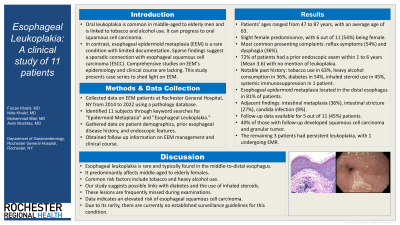Monday Poster Session
Category: Esophagus
P1813 - Esophageal Leukoplakia: A Clinical Study of 11 Patients
Monday, October 23, 2023
10:30 AM - 4:15 PM PT
Location: Exhibit Hall

Has Audio

Faizan Khalid, MD
Emory University School of Medicine
Atlanta, Georgia
Presenting Author(s)
Faizan Khalid, MD1, Mohammad Bilal, MD2, Nida Khalid, MD2, Asim Mushtaq, MD2
1Emory University School of Medicine, Atlanta, GA; 2Rochester General Hospital, Rochester, NY
Introduction: Oral leukoplakia is a common, painless disorder primarily affecting middle-aged to elderly men, associated with tobacco smoking and alcohol use. It can lead to oral squamous cell carcinoma with specific histological features. Conversely, esophageal epidermoid metaplasia (EEM) is a rare condition poorly documented in the literature. Limited findings suggest a sporadic association with esophageal squamous cell carcinoma (ESCC), but comprehensive studies on EEM's epidemiology, endoscopic and clinical course are lacking. This study presents case series aiming to provide insights into EEM
Methods: We collected data on EEM patients at Rochester General Hospital, NY from 2014 to 2022, using a pathology database. Keyword searches for "epidermoid metaplasia" and "esophageal leukoplakia" identified 11 subjects. Data included patient demographics, prior esophageal disease history and endoscopic features. Follow-up information on EEM management and clinical course was also obtained.
Results: Patients ranged in age from 47 to 87 years (mean 63), with a slight female predominance (6/11, 54%). On presentation, a majority of patients complained of reflux symptoms (6/11, 54%) or dysphagia (4/11, 36%). 8 out of 11(72%) patients had prior endoscopic exam within 1 to 6 years (Mean 3.6) with no mention of leukoplakia on exam. Past history was notable for current or former tobacco use in 7 (63%), heavy alcohol consumption in 4 (36%), diabetes in 6 (54%), use of inhaled steroids in 5 (45%) and systemic immunosuppression in 1 patient. In 9 (81%) patients esophageal epidermoid metaplasia was located within the distal esophagus. Adjacent intestinal metaplasia, intestinal stricture and candida infection were seen in 4 (36%), 3(27%) and 1(9%) patient respectively. Follow-up information was available for 5 out of 11 (45%). 2 out of 5 (40%) developed squamous cell carcinoma and granular tumor. Rest of the 3 patients were found to have persistent leukoplakia. EMR was performed for 1 patients.
Discussion: Esophageal leukoplakia is rare, primarily affecting the middle-to-distal esophagus in middle-aged to elderly females with risk factors like tobacco and heavy alcohol use. Our study suggests links to diabetes and inhaled steroids. These lesions are often overlooked in exams. Data indicates an elevated risk of esophageal squamous cell carcinoma. Guidelines on surveillance have yet to be established due to the rarity of the disease.
Disclosures:
Faizan Khalid, MD1, Mohammad Bilal, MD2, Nida Khalid, MD2, Asim Mushtaq, MD2. P1813 - Esophageal Leukoplakia: A Clinical Study of 11 Patients, ACG 2023 Annual Scientific Meeting Abstracts. Vancouver, BC, Canada: American College of Gastroenterology.
1Emory University School of Medicine, Atlanta, GA; 2Rochester General Hospital, Rochester, NY
Introduction: Oral leukoplakia is a common, painless disorder primarily affecting middle-aged to elderly men, associated with tobacco smoking and alcohol use. It can lead to oral squamous cell carcinoma with specific histological features. Conversely, esophageal epidermoid metaplasia (EEM) is a rare condition poorly documented in the literature. Limited findings suggest a sporadic association with esophageal squamous cell carcinoma (ESCC), but comprehensive studies on EEM's epidemiology, endoscopic and clinical course are lacking. This study presents case series aiming to provide insights into EEM
Methods: We collected data on EEM patients at Rochester General Hospital, NY from 2014 to 2022, using a pathology database. Keyword searches for "epidermoid metaplasia" and "esophageal leukoplakia" identified 11 subjects. Data included patient demographics, prior esophageal disease history and endoscopic features. Follow-up information on EEM management and clinical course was also obtained.
Results: Patients ranged in age from 47 to 87 years (mean 63), with a slight female predominance (6/11, 54%). On presentation, a majority of patients complained of reflux symptoms (6/11, 54%) or dysphagia (4/11, 36%). 8 out of 11(72%) patients had prior endoscopic exam within 1 to 6 years (Mean 3.6) with no mention of leukoplakia on exam. Past history was notable for current or former tobacco use in 7 (63%), heavy alcohol consumption in 4 (36%), diabetes in 6 (54%), use of inhaled steroids in 5 (45%) and systemic immunosuppression in 1 patient. In 9 (81%) patients esophageal epidermoid metaplasia was located within the distal esophagus. Adjacent intestinal metaplasia, intestinal stricture and candida infection were seen in 4 (36%), 3(27%) and 1(9%) patient respectively. Follow-up information was available for 5 out of 11 (45%). 2 out of 5 (40%) developed squamous cell carcinoma and granular tumor. Rest of the 3 patients were found to have persistent leukoplakia. EMR was performed for 1 patients.
Discussion: Esophageal leukoplakia is rare, primarily affecting the middle-to-distal esophagus in middle-aged to elderly females with risk factors like tobacco and heavy alcohol use. Our study suggests links to diabetes and inhaled steroids. These lesions are often overlooked in exams. Data indicates an elevated risk of esophageal squamous cell carcinoma. Guidelines on surveillance have yet to be established due to the rarity of the disease.
Disclosures:
Faizan Khalid indicated no relevant financial relationships.
Mohammad Bilal indicated no relevant financial relationships.
Nida Khalid indicated no relevant financial relationships.
Asim Mushtaq indicated no relevant financial relationships.
Faizan Khalid, MD1, Mohammad Bilal, MD2, Nida Khalid, MD2, Asim Mushtaq, MD2. P1813 - Esophageal Leukoplakia: A Clinical Study of 11 Patients, ACG 2023 Annual Scientific Meeting Abstracts. Vancouver, BC, Canada: American College of Gastroenterology.
